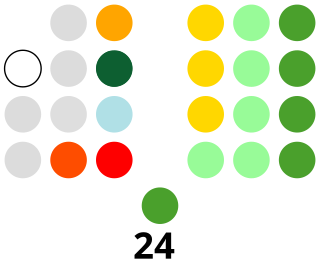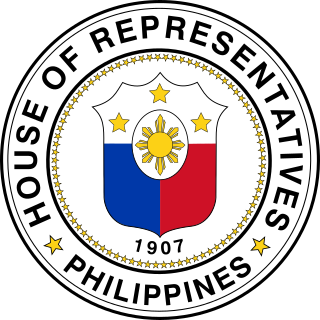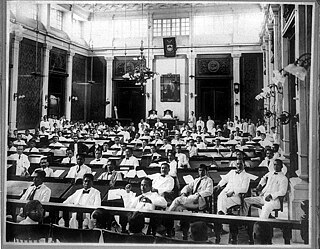
The senatorial districts of the Philippines were the representations of the provinces of the Philippines in the Philippine Senate from 1916 to 1935.

The senatorial districts of the Philippines were the representations of the provinces of the Philippines in the Philippine Senate from 1916 to 1935.
The enactment of the Philippine Autonomy Act (popularly known as "Jones Law") in August 1916 by the United States Congress provided for the creation of a bicameral legislature consisting of a lower chamber (House of Representatives) and an upper chamber (Senate). Until then the Philippine Commission held the executive power and some legislative powers over the American colony.
The system of government of the Philippines in its early years of transition to democratic self-government was deliberately structured to emulate the American model. The Philippines thus followed the American system of electing the members of the 24-seat senate by district.
The districts were organized and numbered in a roughly north–south fashion, much like the present administrative regions. The first eleven districts were composed of established provinces, while the twelfth was composed of the provinces of the Luzon interior and much of Mindanao – both of which were never fully administered by the old Spanish colonial government and designated by American authorities as "non-Christian" areas.
The first to eleventh districts elected two senators each by popular vote. The two senators from the twelfth district were appointed by the U.S. governor-general. The setup lasted until the establishment of the Commonwealth of the Philippines in 1935, when the bicameral legislature was abolished, as the 1935 Constitution provided only for a unicameral National Assembly. However, when the Constitution was amended in 1940 to re-establish a bicameral Congress, members of the Senate had to be voted at-large, thereby effectively abolishing the district system.

A senate is a deliberative assembly, often the upper house or chamber of a bicameral legislature. The name comes from the ancient Roman Senate, so-called as an assembly of the senior and therefore considered wiser and more experienced members of the society or ruling class. However the Roman Senate was not the ancestor or predecessor of modern parliamentarism in any sense, because the Roman senate was not a de jure legislative body.

The Congress of the Philippines is the legislature of the national government of the Philippines. It is bicameral, composed of a lower body, the House of Representatives, although colloquially the term "Congress" commonly refers to just the latter, and an upper body, the Senate. The House of Representatives meets in the Batasang Pambansa in Quezon City while the Senate meets in the GSIS Building in Pasay.

The House of Representatives of the Philippines is the lower house of Congress, the bicameral legislature of the Philippines, with the Senate of the Philippines as the upper house. The lower house is usually called Congress, although the term collectively refers to both houses.

The Senate of the Philippines is the upper house of Congress of the bicameral legislature of the Philippines with the House of Representatives as the lower house. The Senate is composed of 24 senators who are elected at-large under plurality-at-large voting.
The legislative districts of the Philippines are the divisions of the Philippines' provinces and cities for representation in the various legislative bodies. Congressional districts are for House of Representatives, while there are districts for Sangguniang Panlalawigan, and some Sangguniang Panlungsod. For purposes of representation, the Senate, most Sangguniang Panlungsod, Sangguniang Bayan, Sangguniang Barangay and Sangguniang Kabataan are all elected at-large, although there were districts for the Senate from 1916 to 1935.

The National Assembly of the Philippines refers to the legislature of the Commonwealth of the Philippines from 1935 to 1941, and of the Second Philippine Republic during the Japanese occupation. The National Assembly of the Commonwealth was created under the 1935 Constitution, which served as the Philippines' fundamental law to prepare it for its independence from the United States of America.

The Philippine Legislature was the legislature of the Philippines from 1907 to 1935, during the American colonial period, and predecessor of the current Congress of the Philippines. It was bicameral and the legislative branch of the Insular Government.
Philippines's 1st senatorial district, officially the First Senatorial District of the Philippine Islands, was one of the twelve senatorial districts of the Philippines in existence between 1916 and 1935. It elected two members to the Senate of the Philippines, the upper chamber of the bicameral Philippine Legislature under the Insular Government of the Philippine Islands for each of the 4th to 10th legislatures. The district was created under the 1916 Jones Law from the northern Luzon provinces of Batanes, Cagayan, Ilocos Norte, Ilocos Sur and Isabela. Abra was added in 1917 upon its re-establishment as a regular province separate from Ilocos Sur.
Philippines's 2nd senatorial district, officially the Second Senatorial District of the Philippine Islands, was one of the twelve senatorial districts of the Philippines in existence between 1916 and 1935. It elected two members to the Senate of the Philippines, the upper chamber of the bicameral Philippine Legislature under the Insular Government of the Philippine Islands for each of the 4th to 10th legislatures. The district was created under the 1916 Jones Law from the west-central Luzon provinces of La Union, Pangasinan and Zambales.
Philippines's 3rd senatorial district, officially the Third Senatorial District of the Philippine Islands, was one of the twelve senatorial districts of the Philippines in existence between 1916 and 1935. It elected two members to the Senate of the Philippines, the upper chamber of the bicameral Philippine Legislature under the Insular Government of the Philippine Islands for each of the 4th to 10th legislatures. The district was created under the 1916 Jones Law from the east-central Luzon provinces of Bulacan, Nueva Ecija, Pampanga and Tarlac.
Philippines's 4th senatorial district, officially the Fourth Senatorial District of the Philippine Islands, was one of the twelve senatorial districts of the Philippines in existence between 1916 and 1935. It elected two members to the Senate of the Philippines, the upper chamber of the bicameral Philippine Legislature under the Insular Government of the Philippine Islands for each of the 4th to 10th legislatures. The district was created under the 1916 Jones Law from the capital Manila and adjacent provinces in south-central Luzon, namely Bataan, Laguna and Rizal.
Philippines's 5th senatorial district, officially the Fifth Senatorial District of the Philippine Islands, was one of the twelve senatorial districts of the Philippines in existence between 1916 and 1935. It elected two members to the Senate of the Philippines, the upper chamber of the bicameral Philippine Legislature under the Insular Government of the Philippine Islands for each of the 4th to 10th legislatures. The district was created under the 1916 Jones Law from the southern Luzon provinces of Batangas, Cavite, Mindoro and Tayabas. Marinduque was added in 1920 upon its re-establishment as a regular province separate from Tayabas.
Philippines's 6th senatorial district, officially the Sixth Senatorial District of the Philippine Islands, was one of the twelve senatorial districts of the Philippines in existence between 1916 and 1935. It elected two members to the Senate of the Philippines, the upper chamber of the bicameral Philippine Legislature under the Insular Government of the Philippine Islands for each of the 4th to 10th legislatures. The district was created under the 1916 Jones Law from the southern Luzon provinces of Albay, Ambos Camarines and Sorsogon. Ambos Camarines was split into the provinces of Camarines Norte and Camarines Sur in 1919, and Masbate was added in 1920 upon its re-establishment as a regular province separate from Sorsogon.
Philippines's 7th senatorial district, officially the Seventh Senatorial District of the Philippine Islands, was one of the twelve senatorial districts of the Philippines in existence between 1916 and 1935. It elected two members to the Senate of the Philippines, the upper chamber of the bicameral Philippine Legislature under the Insular Government of the Philippine Islands for each of the 4th to 10th legislatures. The district was created under the 1916 Jones Law from the western Visayas provinces of Capiz and Iloilo. Romblon was added in 1917 upon its re-establishment as a regular province separate from Capiz.
Philippines's 8th senatorial district, officially the Eighth Senatorial District of the Philippine Islands, was one of the twelve senatorial districts of the Philippines in existence between 1916 and 1935. It elected two members to the Senate of the Philippines, the upper chamber of the bicameral Philippine Legislature under the Insular Government of the Philippine Islands for each of the 4th to 10th legislatures. The district was created under the 1916 Jones Law from the western Visayas provinces of Antique, Negros Occidental, Negros Oriental and Palawan.
Philippines's 9th senatorial district, officially the Ninth Senatorial District of the Philippine Islands, was one of the twelve senatorial districts of the Philippines in existence between 1916 and 1935. It elected two members to the Senate of the Philippines, the upper chamber of the bicameral Philippine Legislature under the Insular Government of the Philippine Islands for each of the 4th to 10th legislatures. The district was created under the 1916 Jones Law from the eastern Visayas provinces of Leyte and Samar.
Philippines's 10th senatorial district, officially the Tenth Senatorial District of the Philippine Islands, was one of the twelve senatorial districts of the Philippines in existence between 1916 and 1935. It elected two members to the Senate of the Philippines, the upper chamber of the bicameral Philippine Legislature under the Insular Government of the Philippine Islands for each of the 4th to 10th legislatures. The district was created under the 1916 Jones Law from the central Visayas province of Cebu.
Philippines's 11th senatorial district, officially the Eleventh Senatorial District of the Philippine Islands, was one of the twelve senatorial districts of the Philippines in existence between 1916 and 1935. It elected two members to the Senate of the Philippines, the upper chamber of the bicameral Philippine Legislature under the Insular Government of the Philippine Islands for each of the 4th to 10th legislatures. The district was created under the 1916 Jones Law from the central Visayas province of Bohol and the northern Mindanao provinces of Misamis and Surigao. Misamis was split into the provinces of Misamis Occidental and Misamis Oriental in 1929.
Philippines's 12th senatorial district, officially the Twelfth Senatorial District of the Philippine Islands, was one of the twelve senatorial districts of the Philippines in existence between 1916 and 1935. Unlike the first eleven districts which elected two members each to the Senate of the Philippines, the upper chamber of the bicameral Philippine Legislature under the Insular Government of the Philippine Islands, the two senators from this district were appointed by the Governor-General of the Philippines to serve indefinite terms in the 4th to 10th legislatures. The district was created under the 1916 Jones Law to represent the non-Christian tribes of the northern Luzon provinces of Mountain Province and Nueva Vizcaya, the city of Baguio, and the Moro people and other non-Christian tribes of the Department of Mindanao and Sulu provinces of Agusan, Bukidnon, Cotabato, Davao, Lanao, Sulu and Zamboanga.